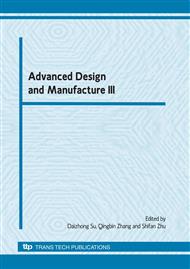p.341
p.345
p.349
p.353
p.357
p.361
p.365
p.369
p.373
A Research of V-Belt Transmission Mechanics with Two Same Pulleys
Abstract:
V-belt is made of a special anisotropic material, its material and pulley groove structure make the V-belt drive mechanics complicated. The elasticity limit, seating and unseating effects, radial compliance makes us consider the macro features of the drive and not to consider the material heterogeneity. We focus on the steady mechanics of V-belt drive in the state of sliding friction between groove and belt. The pulley groove leads to two-dimensional radial and tangential friction forces whose direction depends on the relative speed between belt and the pulley along the contact arc. The belt model is analyzed with comparing method which is performed through acquiring the equivalent coefficient of friction, and replacing the coefficient of friction in the flat belt mechanical equilibrium equations for v-belt analysis. Through the sample calculation it is proved that this method is simple and valid for V-belt mechanical analysis.
Info:
Periodical:
Pages:
357-360
Citation:
Online since:
November 2010
Authors:
Price:
Сopyright:
© 2011 Trans Tech Publications Ltd. All Rights Reserved
Share:
Citation:


